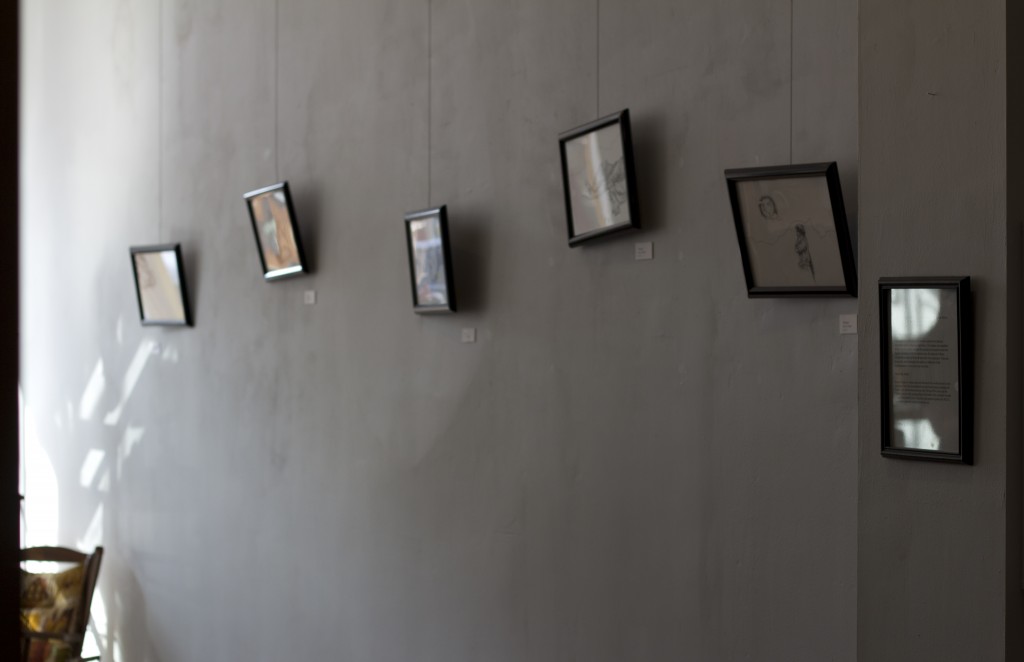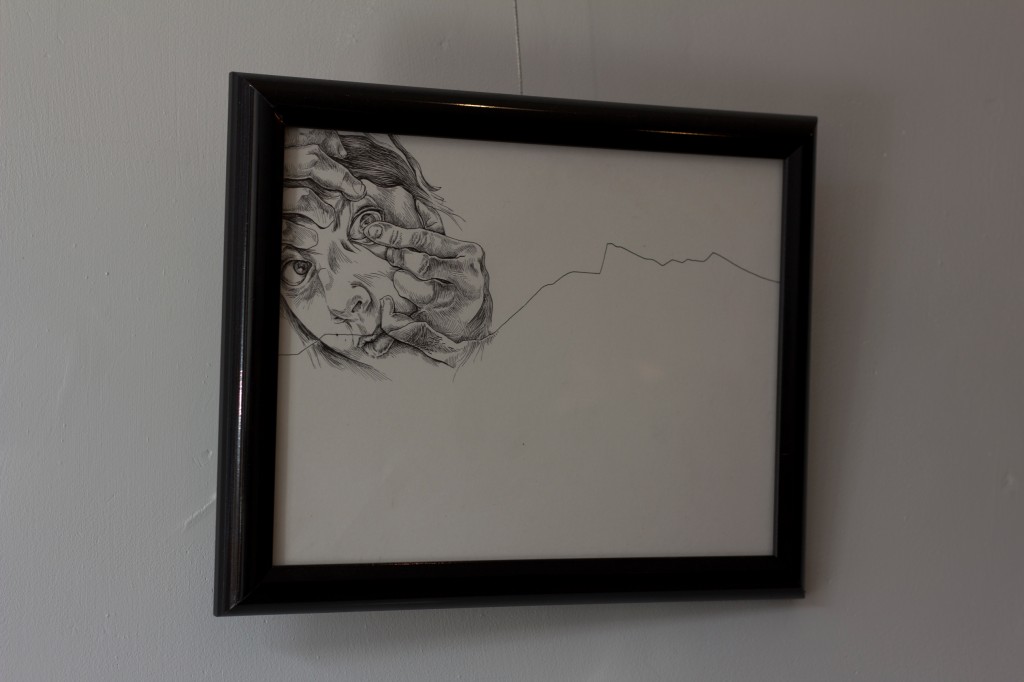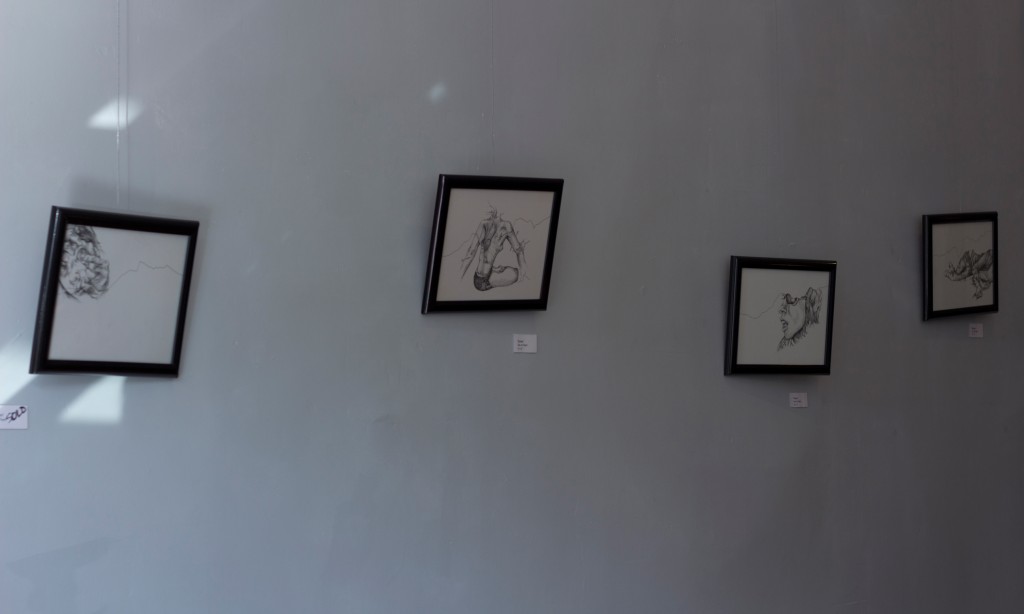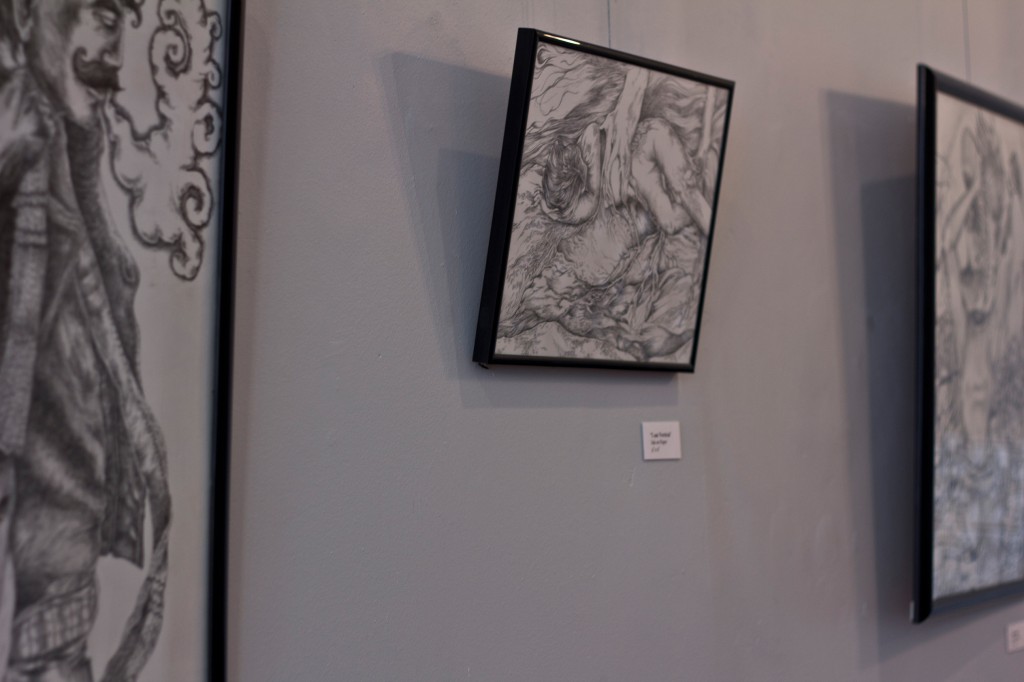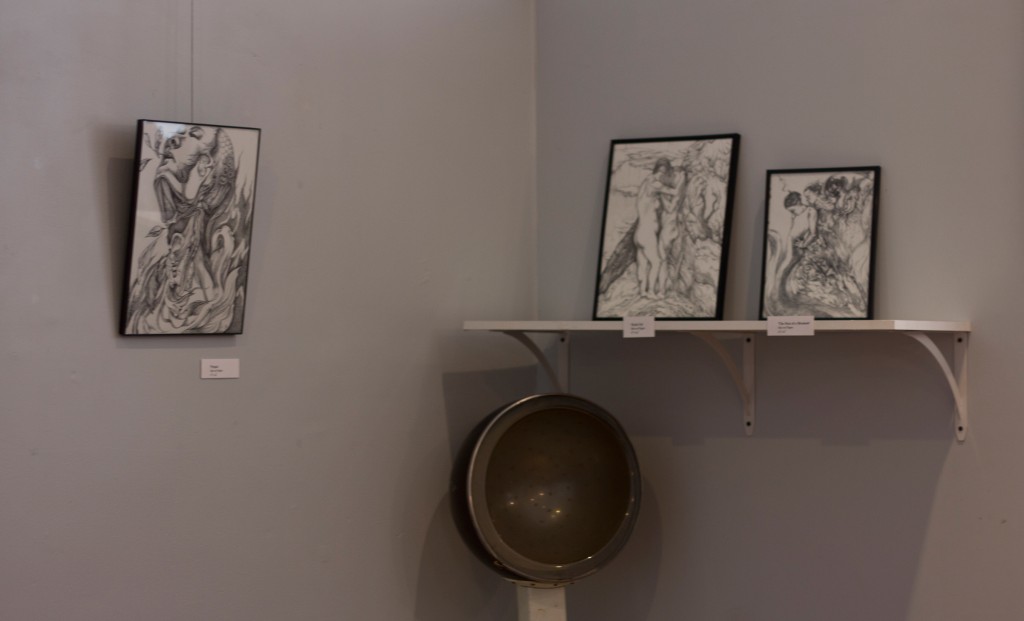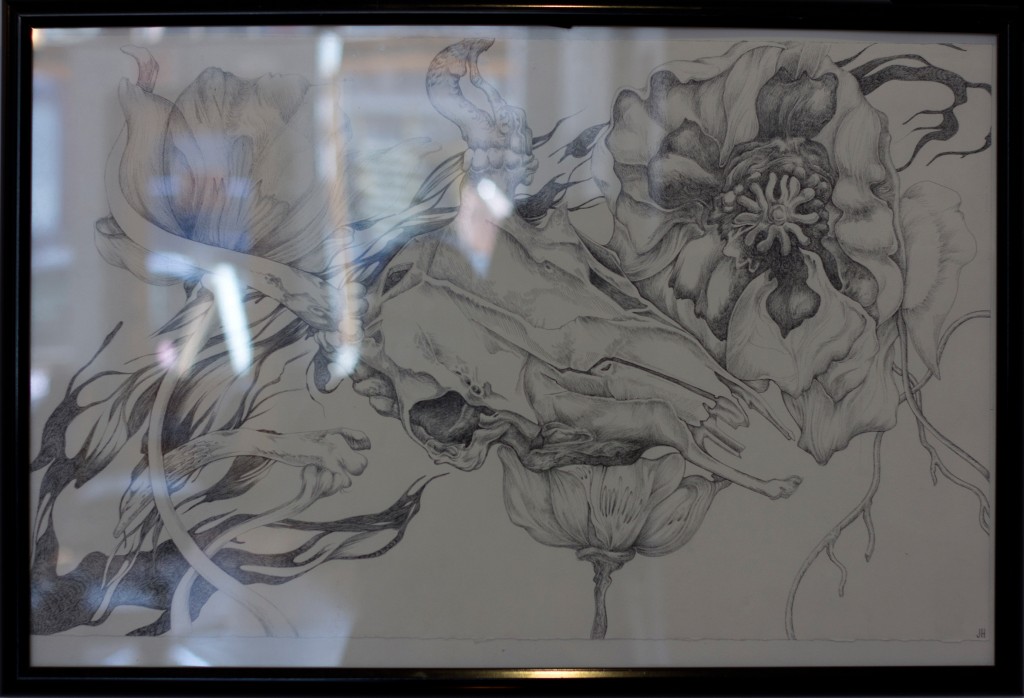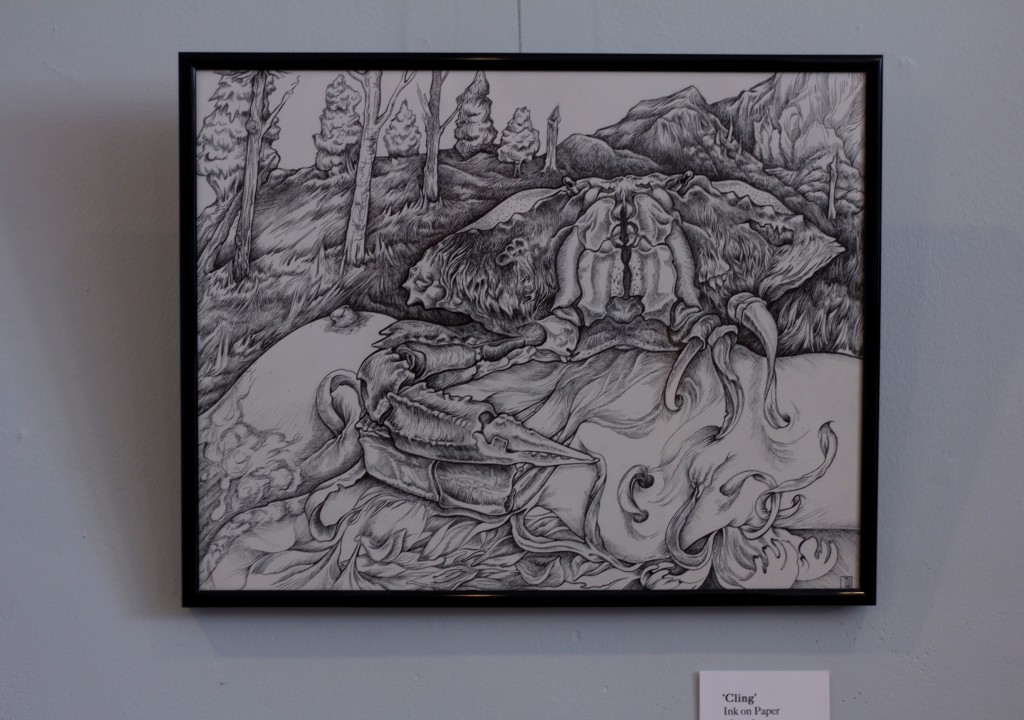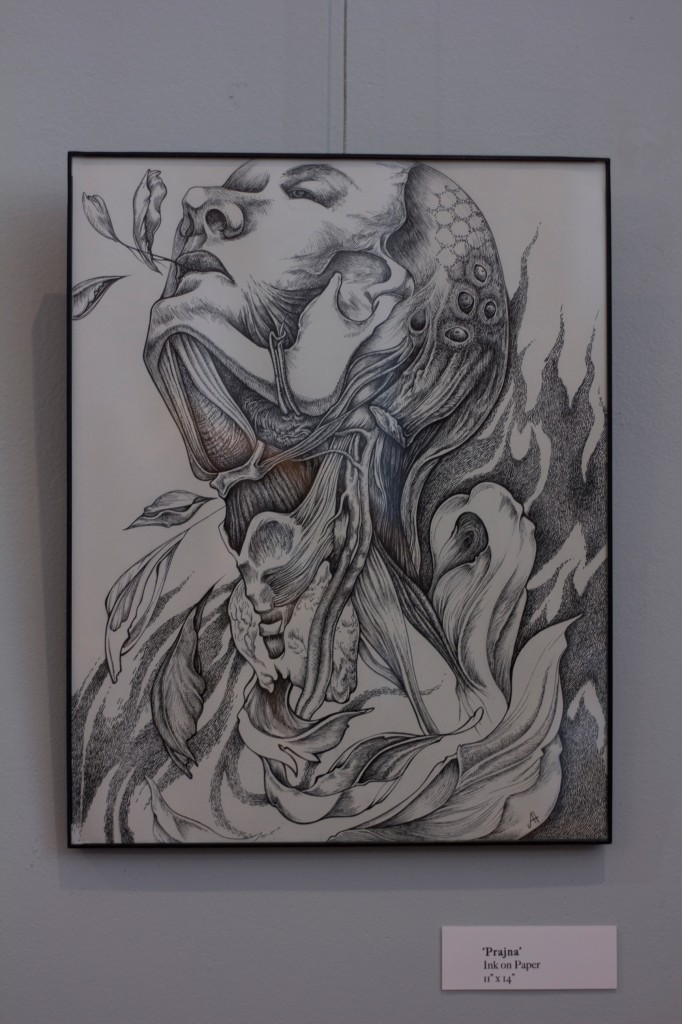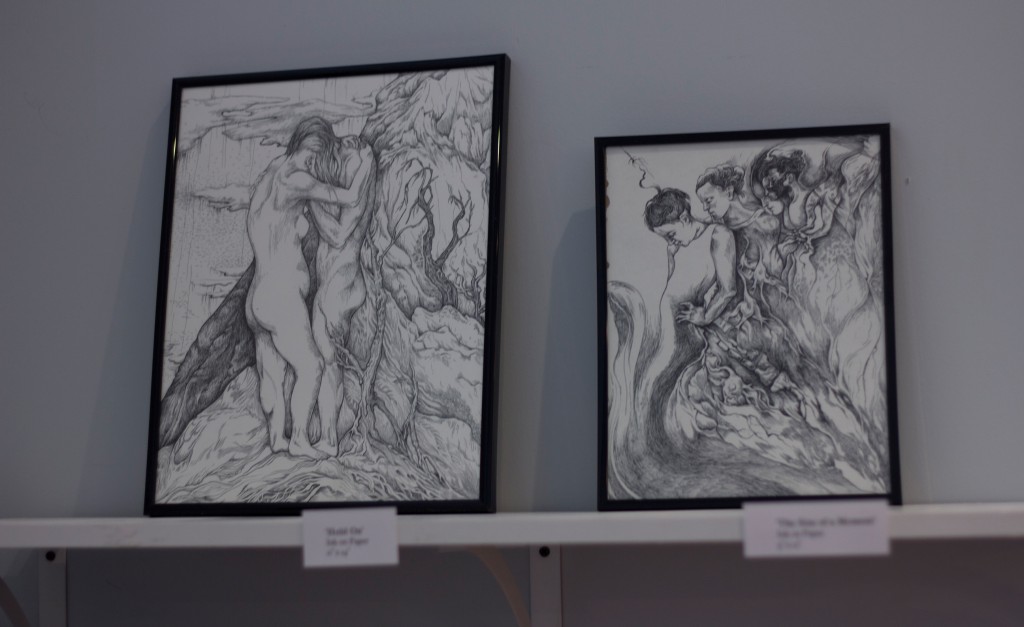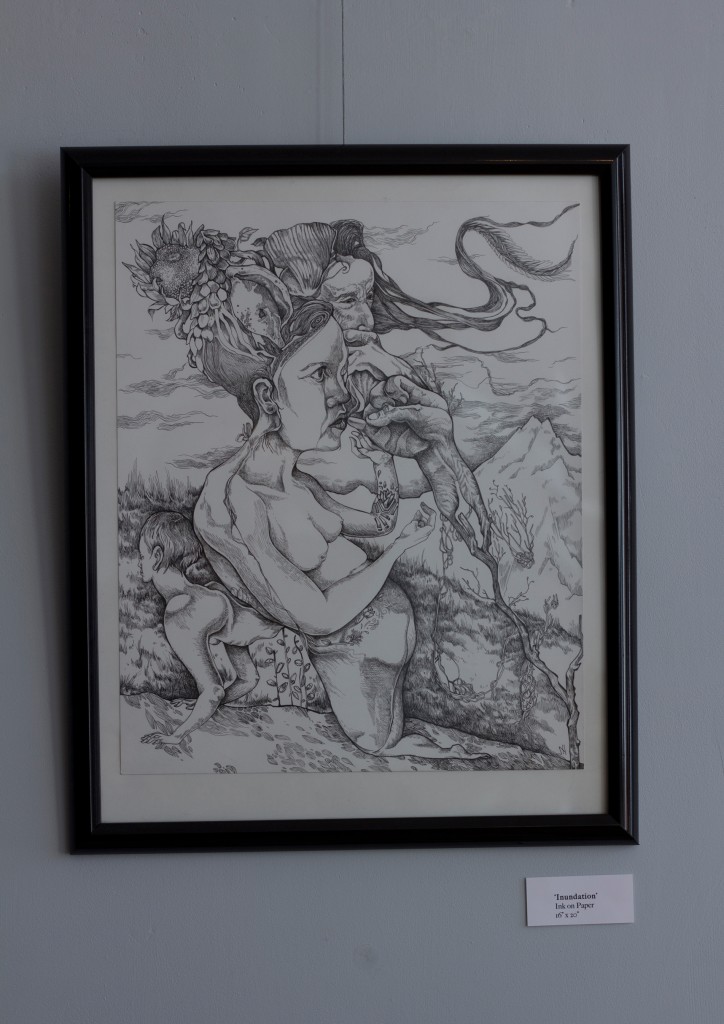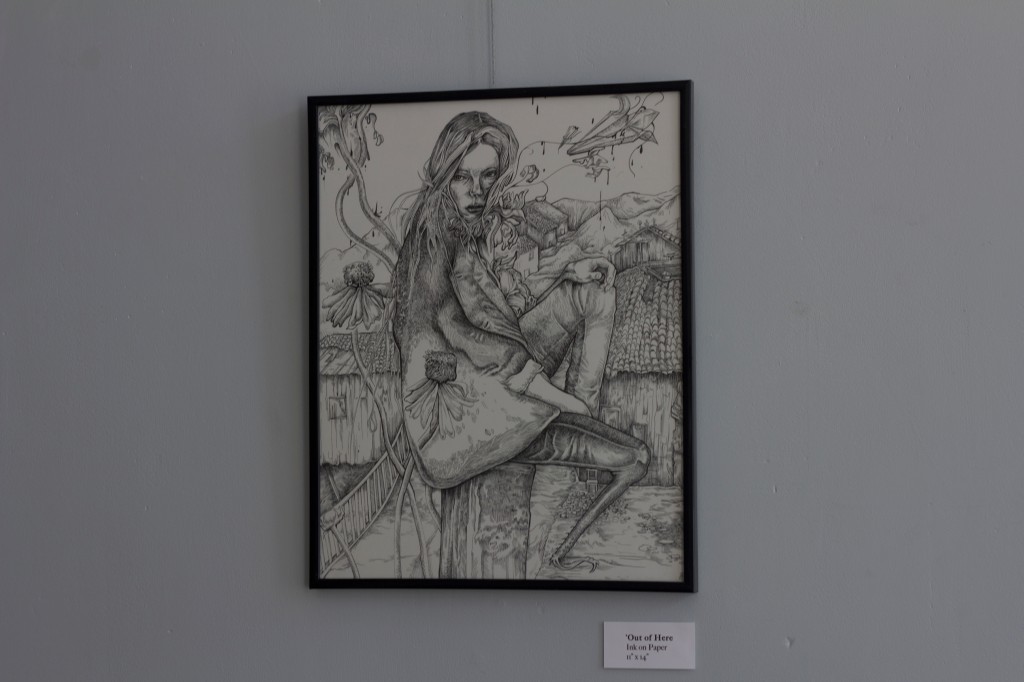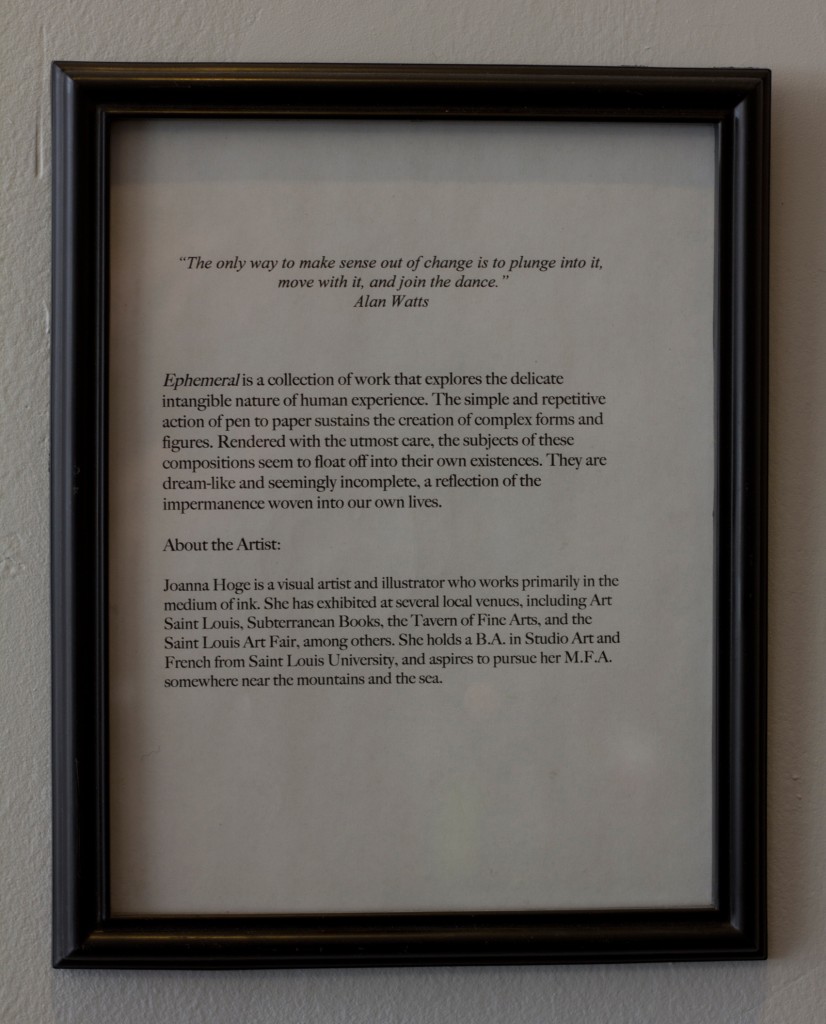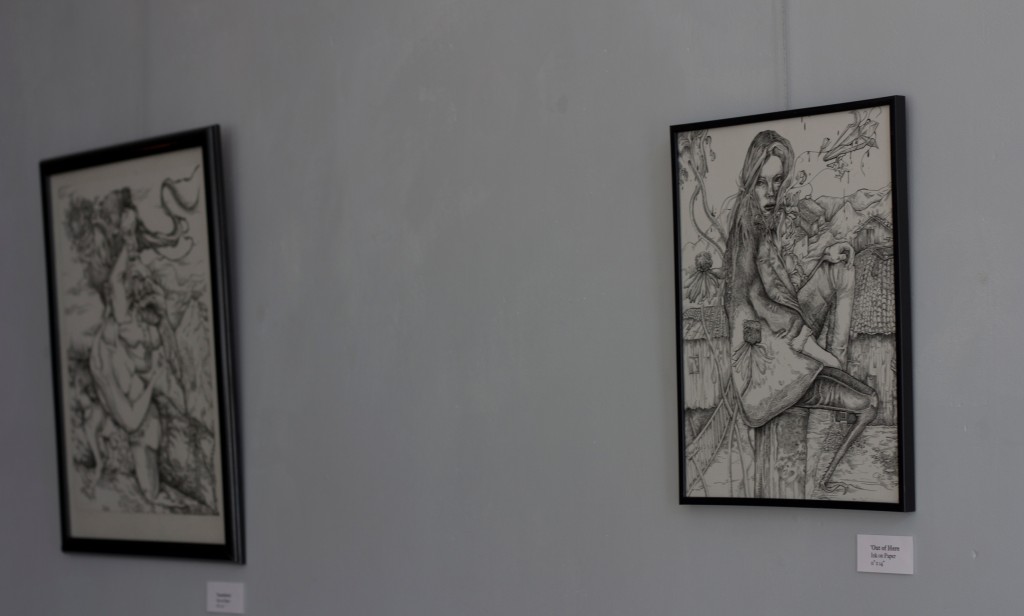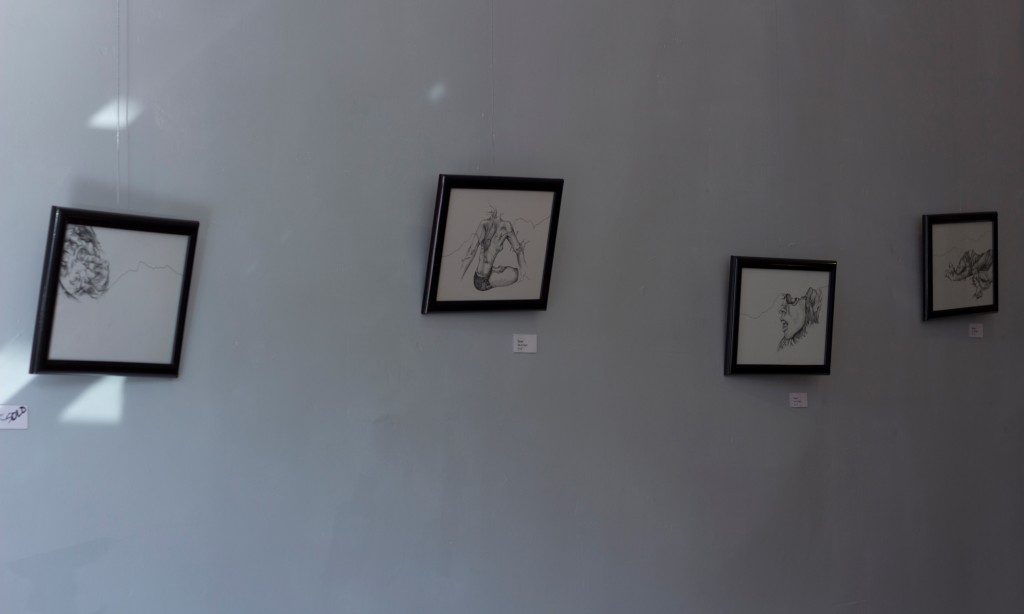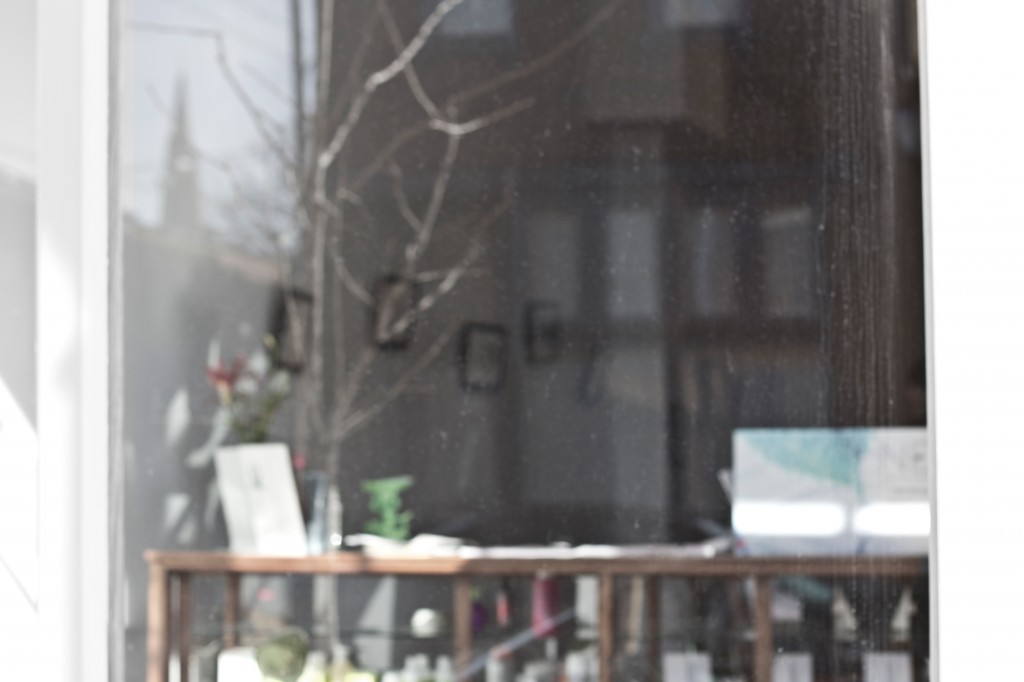I first laid eyes on the artwork of Joanna Hoge as an undergrad at Saint Louis University. The deliberate and concentrated lines in her ink-based drawings instantly captured my attention and continue to haunt me to this day (in the best of ways). The authenticity of her artwork made me an instant fan and keeps me wanting more. For a medium so straightforward, a piece of paper and a pen, it’s anything but that. These ethereal creations are involved, begging the viewer to stay a while, revealing more as the eye adjusts. Every line has a purpose, facilitating and illustrating the stories she tells.
While at Saint Louis University, Joanna earned her BA in Studio Art and would like to return to school to get her MFA. Post graduation, she continued her involvement with the Saint Louis art community, curating a handful of shows and exhibiting her work locally.
A couple of months ago I was fortunate enough to view Joanna’s latest exhibit, Ephemeral, at the Drew Henry Salon & Gallery on Cherokee Street. In this interview, we concentrate on this existential body of work, who Joanna is, what she does, where she’s from and where’s she going. Read on and learn about this up-and-coming artist.
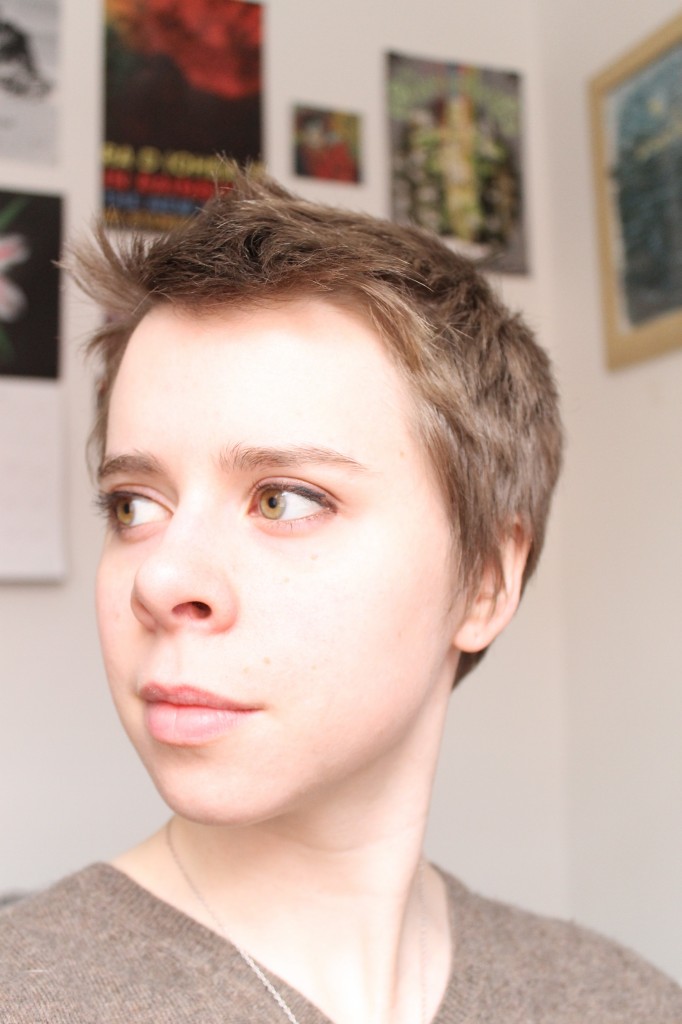
Emily Frankoski: Tell us a little about yourself. What makes you tick? Who is Joanna Hoge?
Joanna Hoge: I enjoy traditional cappuccinos, poetry, and the woods. Sometimes I feel too cynical to read Thich Nhat Hahn, and most times I do it anyway.
EF: What is your hometown and where do you currently reside?
JH: My parents left Fairfax, VA when my brother and I were three years old. I still consider myself a transplant after twenty years in the Midwest. Currently, I live in the city of Saint Louis, within walking distance of Forest Park.
EF: How long have you been involved with art?
JH: My involvement with art started at a fairly young age. My mom was always really good at encouraging us to try new activities. There were gymnastics, acting, modern dance, band, and at least five different sports. Art just happened to be one of the only things that stuck.
EF: What is your background in art?
JH: I graduated from Saint Louis University with a BA in Studio Art. I’ve been lucky enough to curate a few local shows in addition to exhibiting my own work across town.
EF: What led you towards art as career? Did you always want to be an artist?
JH: I played with the idea quite a bit in high school but felt like I was being told that it wouldn’t be enough, that I needed a back-up plan. In the end, it was a matter of knowing that I could spend entire days just sketching and drawing. Those experiences alone trumped whatever negative feedback I received at the time.
EF: Describe your growth & development in the arts as an undergrad.
JH: It didn’t seem to take me as long as some of my colleagues to figure out what my niche was. This was also a quality that seemed to work against me at times. It was a personal struggle to try and reframe myself as an artist until I realized I didn’t need to do that. I just had to dig deeper into the work I already found myself doing. It is essential for me to say that this recognition came out of numerous long conversations with my professors and friends in the program.
EF: How has your career as an artist progressed since graduating from SLU? Do you think you have grown in the meantime? If yes, how is it shown in your work?
JH: Growth doesn’t always appear as upward movement. You spend some time putzing around on the sidelines. You equally spend time looking up from what seems like the bottom of a very deep well. After graduation, I did quite a lot of both. The difference was that I continued to make art. If I felt completely stuck and hopeless, I would draw. If I felt like I was making progress in several arenas, I would draw. Not everything I’ve made post-graduation is worth showing, but I’ve fleshed out projects that I wouldn’t have conceived of in earlier years. This, to me, is progress.
EF: Do you plan on continuing your education?
JH: Graduate school, (going back for an MFA), is a long-term goal of mine. Even if I don’t pursue teaching at the collegiate level, I believe the experience would be invaluable.
EF: How do you get your work “out there” for public consumption?
JH: I talk to people. Being tattooed has inadvertently inspired numerous conversations with others about art. Most people are interested to know that I’ve designed much of the work I have on my body. I guess I’ve also been fairly persistent in emailing gallery owners, perusing coffee shops for available wall space, and looking at open calls.
EF: What is your dominant medium?
JH: Most all of my work is made with ink. It can be very unforgiving, but this also becomes a source of satisfaction. You learn to be more intentional with the marks you make and to work with mistakes instead of hiding them.
EF: Do you have a favorite type of pen you prefer to use? Paper preference?
JH: Pilot’s Precise V5. I’m usually less discerning when it comes to paper.
EF: Can you walk us through your artistic process? From conception – to development – to eventual execution.
JH: Nothing is ever cut and dried with the process. Sometimes I start with a clear objective and sometimes with a muddled emotion. I would say that I work better if I don’t try and lay out everything beforehand. My influences are what I cling to, and the best decisions about the drawing come while in the midst of drawing.
EF: Do you work on pieces all at once or over a long period of time? How long (on average) does it take to finalize a piece?
JH: I try and finish a piece within a month of starting it, depending on the size. One of the drawings I had in my most recent show, however, took me a year to wrap up. I would lose interest and bury it in my studio for months. Amidst a wreck of unfinished drawings it managed to resurface.
EF: How do you decide on the size of the piece you will create? Do you start with a standard paper size and then work from there OR do you come up with an idea and choose the paper accordingly?
JH: I’ve tended towards paper sizes that are smaller and more approachable. I focus a lot of attention on details, so it seemed to complement my way of working in the past. More recently, I’ve been interested in experimenting with larger scale.
EF: What inspires your creations?
JH: Buddhist philosophy, daily life, nature.
EF: If you are stuck and can’t decide what to draw, how do you get around that mental “block” preventing your progress? Any tricks on getting back to productivity? Coffee/sleep/reading/music?
JH: I haven’t yet discovered a formula that works in every instance. It could be a trip to the art museum or a long stint at a café. Sometimes drawing itself is the antidote.
EF: Where do you create?
JH: I’ve carved out a studio space in my apartment, with an adequately sized desk and a large window. In spite of this, most work still gets done on the couch.
EF: Do you work with any other medium?
JH: Colored pencil from time to time, when I’m feeling patient.
EF: Your recent work relies less on color. Why is that?
JH: When I conceive of a piece, I don’t think of it in color. I’ve heard people talk about the ability of color to express emotion, but there is so much potential for line and value to do the same. I’ve always been more interested in exploring the dichotomy between complexity and simplicity in mark-making.
EF: Do you sell your art, and if so, where can one make a purchase?
JH: I sell both original work and prints. Those interested can email me directly.
EF: Where has your work been showcased/exhibited (venue/title/date)?
JH: Mokabee’s/ May 2010-Jul. 2010
Art Saint Louis/ Varsity Art Show/ Mar. 2011-Apr. 2011
Café Ventana/ May 2012
Saint Louis Art Fair/ Aug. 2011
Tavern of Fine Arts/ June 2012
Coliseum/ Radiate / July 2012
Subterranean Books/ Jan. 2013
Drew Henry Salon and Gallery/ Ephemeral/ Jan. 2013
EF: Do you have another exhibition coming up anytime soon?
JH: Not at the moment, although I’m scoping out several locations.
EF: If you had to pick one of your pieces that best describes who you are as an artist, which one would it be and why?
JH: It would have to be a drawing I finished my senior year at SLU, a commission for a piercer at a local tattoo shop. She had given me extremely loose guidelines to work with, which I love. In one of our conversations, she mentioned that she enjoyed ‘things living in or around the ground.’ Despite my initial confusion, I decided to make this an integral part of how I would create the piece. For a month and a half, every day as I walked outside, I kept my eyes peeled for various interesting items on the ground. Feathers, tree branches, seeds, flowers, dead birds, and animal skulls worked their way into the composition. I see this work as testament to my love of small things, and of nature.
EF: What is Ephemeral about? What was the impetus behind this collection of work?
JH: ‘Ephemeral’ embodies an understanding that has stuck with me since I first read the Heart Sutra many years ago. It is an attempt at documenting transience within my own life as something that is equally apparent in the lives of others. The driving force behind this collection is largely existential.
EF: How long did it take you to complete this collection?
JH: Works were selected from the past four years.
EF: How many pieces are in the series?
JH: Sixteen.
EF: What do you hope viewers of your work will take away from these pieces (or your artwork in general)?
JH: In asking questions of the work, I would hope people ask more questions of themselves. The point is not that the viewer comes to my conclusions, but is inspired to draw their own.
EF: Are there prints available?
JH: Yes!
EF: Do you have any other collections besides Ephemeral?
JH: Several of the pieces in Ephemeral belong to a series called ‘Life Lines’. This project explores my interest in recording my emotional highs and lows over time. ‘Animals’ is an ongoing collection of different, unwittingly proposed animal combinations.
EF: What do you do when not creating artwork?
JH: I take walks. I write. I daydream about traveling.
EF: Inspirational music you like to listen to while you create?
JH: I listen to quite a bit of folk music. Sufjan Stevens, Bowerbirds, Hurray for the Riff Raff, and Mirah, among others.
EF: Who is(are) your favorite artist(s)?
JH: Max Ernst, James Jean, and Marco Mazzoni.
EF: What is the best piece of advice you have received thus far?
JH: Do what you do. It’s easy when you hear criticism from the outside world to doubt your own vision, but to falter is missing the point. Listen to the suggestions of others insofar as they challenge you to be better within the scope of what you do.
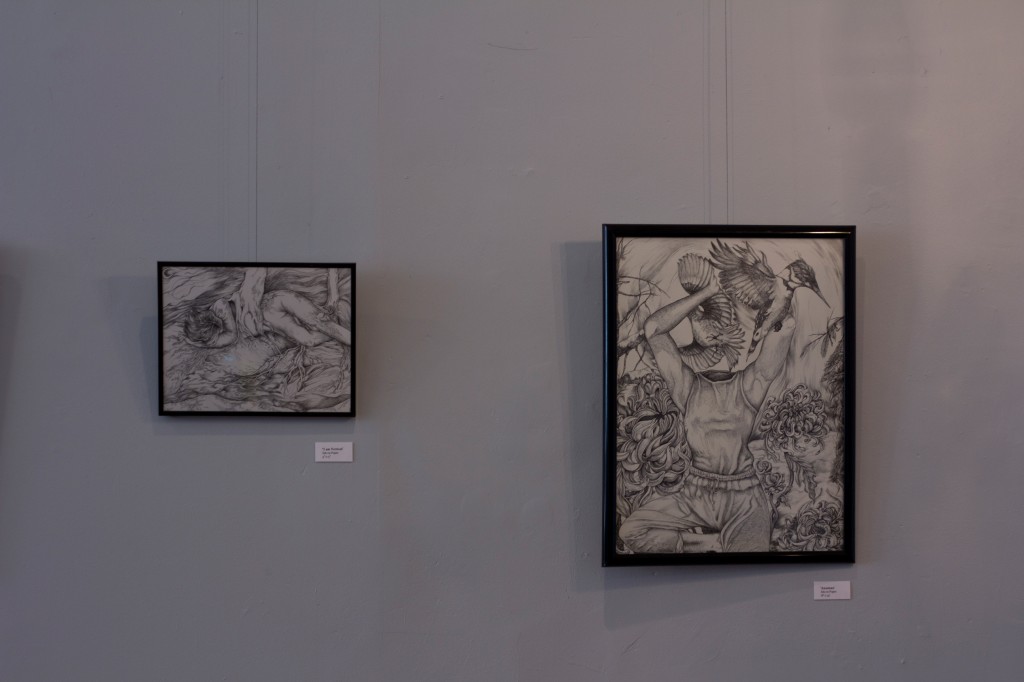
EF: What is(are) your favorite piece(s) of art?
JH: Which of your children is your favorite? (There’s no way I could choose.)
EF: What is your favorite book?
JH: The Power of Now.
EF: Who is your favorite author?
JH: Eckhart Tolle.
EF: What do you plan to do next with your art/are you working on anything new? Where can we see more?
JH: There’s always something in the works 😉
